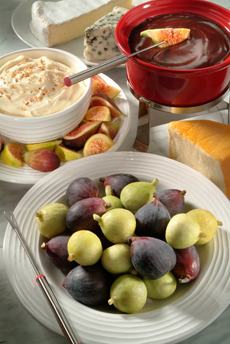TIP OF THE DAY: Ways To Serve Fresh Figs
 It doesn’t get simpler than this: halved ripe cheese topped with a bit of blue cheese or chèvre. Photo courtesy Castello USA. |
We were surprised not too long ago when a friend mentioned she liked figs, but had only eaten figs in their dried form. Why, we asked, since they are easily available? “I didn’t know what to do with them,” she replied. Today’s first tip: Never let unfamiliarity stop you from trying a new food. Buy it, bring it home, look it up. A sweet, soft and moist tree-ripened fig is luscious, eaten plain, with cheese or yogurt, or in many recipes. Just as with, say, fresh versus dried mango, it’s a completely different experience. And the season is now: In the U.S., figs have two seasons: a short season in early summer and a main crop that starts in late summer and runs through fall. Fresh figs are fragile and don’t travel well: The think skins easily split and the flesh can bruise. This makes fresh figs even more of a treat, worth seeking out. THE HISTORY OF FIGS Man has been cultivating figs for more than 11,400 years. It is now believed to be the first food cultivated by man, in the Near East* some 11,400 years ago. This is roughly 1,000 years before the other “earliest crops,” barley, legumes and wheat were domesticated in the region. [Source] |
|
|
Domestication of crops was a tipping point in the evolution of human thinking after 2.5 million years as nomadic hunter-gatherers: the decision to settle down and grow their own food rather than relying on finding food that was growing wild. *According to National Geographic, the terms Near East and Middle East are synonymous. Afghanistan, Armenia, Bahrain, Cyprus, Egypt, the Gaza Strip, Iran, Iraq, Israel, Jordan, Kuwait, Lebanon, Libya, Oman, Palestine, Qatar, Saudi Arabia, Sudan, Syria, Turkey, the United Arab Emirates, the West Bank, and Yemen are included in the definition. According to Wikipedia, different bodies—Encyclopedia Britannica and the United Nations, for example—may exclude some countries and add others. [Source] Figs Today The fig is a member of the Moraceae binomial family, sometimes called the fig family. It’s the family member that’s most familiar to us: Other members include the banyan, breadfruit, mulberry and Osage orange (which not an orange). There are almost 200 cultivars of figs, in a wide range of shapes, colors and textures. While most of think of figs as having skins that are brown, green, red or purple, take a look at the lovely yellow Tiger Stripe Fig. Figs are now grown in warm, dry and sunny climates in around the globe (fig trees can’t tolerate temperatures below 20°F). The top 10 fig producing countries are, by crop size, Turkey, Egypt, Algeria, Morocco, Iran, Syria, United States, Brazil, Albania and Tunisia. |
||
|
HOW TO ENJOY FRESH FIGS Since figs are sweet, we think of them in the context of desserts or sweet snacks. But sweetness is also an excellent counterpoint to bitter, salty and spicy/hot foods. Eat up: Figs are among the richest plant sources of calcium and fiber. They are rich in calcium, copper, iron, magnesium, manganese, phosphorus, potassium and vitamins B6 and K, and are a good source of flavonoids and polyphenols (antioxidants). They are sodium-free and cholesterol/fat-free. Don’t peel the figs. Enjoy them with breakfast cereal, yogurt or cottage cheese; sliced on sandwiches with fresh or aged cheese; chopped and added to rice; stuffed with cream cheese or goat cheese as an hors d’oeuvre; or raw or grilled as a side dish, cut in half and served with grilled meat or poultry. |
|
|
|
Figs For Lunch
Cocktails With Figs
Desserts With Figs If you have too many ripe figs, you can place them on paper towels, cover with plastic wrap and refrigerate them for a few days. Or, place them in a freezer bag and freeze for up to six months. Or, purée the ripe figs and use the purée in cocktails (mixed with white spirits, for example), smoothies, or as a topper for ice cream or sorbet (add sweetener as necessary).
|
||



